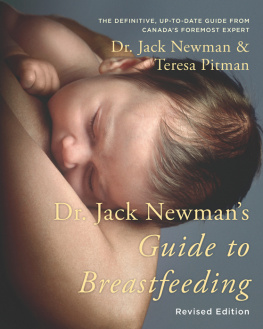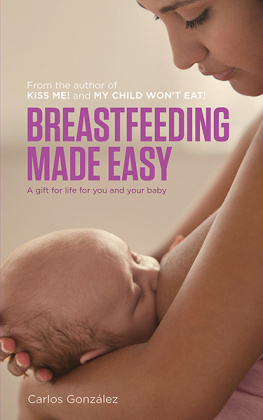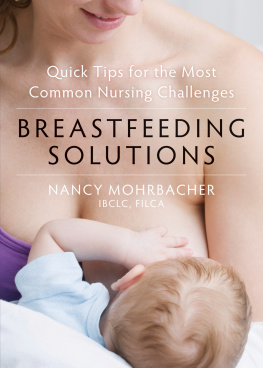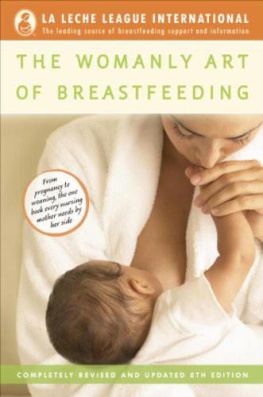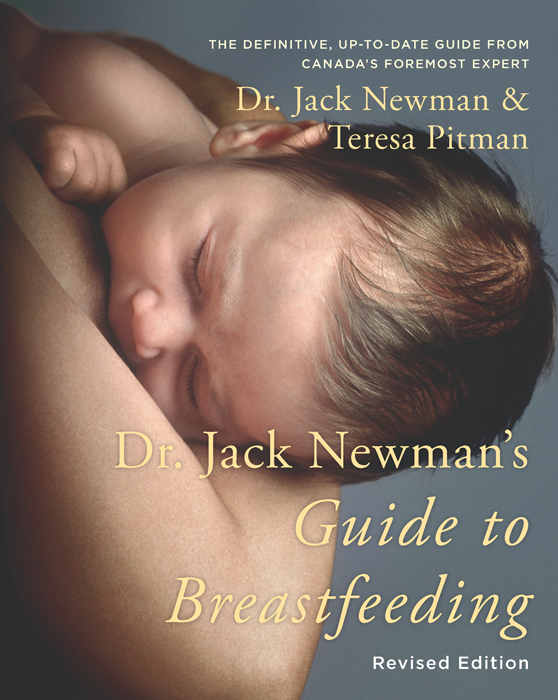Dr. Jack Newman is a Toronto pediatrician who has practised medicine since 1970. In 1984 he established the first hospital-based breastfeeding clinic in Canada, at Torontos Hospital for Sick Children. He is co-founder of the International Breastfeeding Centre located in Toronto, Ontario. He is the father of three children, all breastfed, and the grandfather of two boys, also breastfed.
Teresa Pitman was the executive director of La Leche League Canada for three years, and she has been helping mothers with breastfeeding for more than 30 years. Her articles on parenting and other topics have appeared in Todays Parent, Pregnancy, Baby and Toddler, More, Mothering, Chatelaine and other magazines. Teresa is the author or coauthor of 12 other books on parenting topics, including, most recently, the eighth edition of The Womanly Art of Breastfeeding. She is the mother of four breastfed children, and the grandmother of six breastfed children.
Dr. Jack Newmans
Guide to Breastfeeding
REVISED EDITION
Dr. Jack Newman &
Teresa Pitman

To Adele, Daniel, Elise and David Marc, without whom
I would never have understood any of this, and to Kellie,
who also helped me understand by breastfeeding
Loc and Tevia.
J.N.
To Matthew, Lisa, Daniel and Jeremy, who taught me that
breastfeeding is about more than just giving milk.
And to Sebastian, Callista, Xavier, Keagan, Mackenzie and Dexter,
who continue our family breastfeeding traditions.
T.P.
With special thanks to Andrea Polokova, who has generously shared
her breastfeeding expertise and writing skills and
many of the photos that add so much to this book.
Quick Start:
How to Use This Book (and Your Time!) Wisely
Picking up a book with several hundred pages about breastfeeding can feel daunting. Is there really that much to know about feeding your baby? The answer is yesand no.
While we believe all the information in this book is valuableand in some cases, hard to find anywhere elsenot every mother or health care professional needs to know about every issue or challenge that is covered, and you certainly dont need to know about everything right away. So heres a quick reference guide that will help you find the key information for you and your situation.
Are you pregnant?
Is this your first baby? Maybe you havent made up your mind about breastfeeding or are looking for information to help you understand the differences between breastfeeding and formula feeding. Check out Chapter 1: Why Breastfeeding Is Important. From there, you might like to go to Chapter 4: How Birth Affects Breastfeeding and Chapter 5: The First Few Days. That may give you all you need to get off to a great start with breastfeeding. Wed encourage you to keep the book handy, though, in case you do run into challenges when your baby arrives, or later in your breastfeeding experience, and need some more information.
If this is your second (or later) baby, perhaps you had difficulties or werent able to breastfeed your first, and are hoping to be better prepared this time around. In that case, you might want to also check out Chapter 2: Finding Good Breastfeeding Help and Chapter 3: The Sale and Promotion of Artificial Baby Milk. If you had some specific issues, you can look up those chapters or sections. These may help you in figuring out what went wrong the first time around and guide you in getting the support you need.
Do you have a brand-new baby?
Chapter 5: The First Few Days will probably be your first destination. If you are having specific challenges (perhaps your nipples are sore or your baby has jaundice), look for the chapters dealing with those issues. If you are feeling discouraged or overwhelmed, reading Chapter 1: Why Breastfeeding Is Important might give you some motivation to keep going, and Chapter 2: Finding Good Breastfeeding Help might help you get in touch with the right support person. Chapter 20: Life with a Breastfed Baby may help as well.
Are you breastfeeding but having problems?
Youve come to the right place! The heart of this book is solving breastfeeding problems, and we have information about both common challenges and less-common ones, with ideas that have worked for many mothers. The more common problems (sore nipples, sore breasts) have their own chapters; if your situation is more unusual you may need to check the index for specific information.
In discussing these common problems, we dont want to suggest that all mothers and babies will experience them; many mothers breastfeed without difficulties, especially if theyve had a good start and good advice right from the beginning. Others have minor challenges they can quickly solve on their own or with a little help. And while the problem-solving sections tend to emphasize helping the baby to get more milk, breastfeeding is about more than the milk. When all is going well, its perfectly fineeven desirablefor the baby to have some relaxed times at the breast when hes just nibbling and enjoying the closeness and the soothing sensation of suckling. These are the moments that encourage a long-term breastfeeding relationship.
Is breastfeeding going fine, but youve been told to wean because you are (choose one) needing to take medication, pregnant, scheduled to have some medical tests, going back to work, nursing a toddler or older child, or one of many other reasons?
A check through the index should help you find your situation, along with information so that you can make an educated decision about whether or not to wean (though its almost never necessary). We also have entire chapters on breastfeeding while on medication and the normal duration of breastfeeding.
Are you a health professional, lactation consultant or La Leche League leader using this book as a reference as you work with breastfeeding mothers?
We think youll find this book a comprehensive guide to solving breastfeeding problems. We also encourage you to look at Chapter 1: Why Breastfeeding Is Important, Chapter 2: Finding Good Breastfeeding Help and Chapter 3: The Sale and Promotion of Artificial Baby Milk. Taken together, these three chapters explain how most mothers find themselves in a situation where they want to breastfeed yet end up weaning sooner than they would like, often after weeks of struggling.
For all our readers
Each of the chapters in the book (other than the first) begins with one or more of the myths or misconceptions that people often believe about breastfeeding. We highlight these because they are so common and often create barriers for women who want to breastfeed. Then we let you know the reality behind the myth, with accurate information so you can make educated decisions.
In many places, we mention research and studies that have been done on breastfeeding and related issues. Since the book is already quite thick, we havent included them, but they are all listed at www.breastfeedinginc.ca, in case youd like to read them. We often also refer to video clips, which are hosted on the International Breastfeeding Centres YouTube channel (http://youtube.com/user/IBCToronto). The videos will help you see some of the techniques that can be hard to explain in writing.
Why is this breastfeeding book unique? Surely there are enough books, articles and pamphlets on breastfeeding available that another is not necessary! Women have, of course, managed to breastfeed throughout the human races time on earth without the benefit of breastfeeding experts. In fact, even today there are women who do things very differently from what most lactation experts would recommend. Their babies are not latched on well, they stick to scheduled feedings, they hold the baby in awkward positions. And yet they manage to breastfeed successfully.

